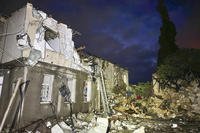It was baptism by fire for USS Callaway as she landed troops at Kwajalein on Jan. 31, 1944. Just months before, Callaway had set sail from her homeport of Norfolk, Va. After embarking Marines in San Diego the ship left for the Pacific and performed their first of several assault landings.
Charles Eichholz was aboard the Callaway during World War II and joined the service in 1944. He recalls he was ready for the unexpected and his service gave him just that.
“I wanted to join. I wanted to get in the Coast Guard and give my parents a little bit of story,” recalls Eichholz.
Eichholz graduated from quartermaster school and from there was shipped to Cedar Island, N.C., where he worked mounted beach patrols. After working the patrols, Eichholz signed up for sea duty and was stationed aboard the Callaway.
Omer Dawson also served aboard the Callaway, but took a different route than his shipmate. After joining in 1941 the service was in need of carpenter’s mates. Dawson earned his way through college as a carpenter so he thought he would give it a try as he arrived in San Pedro, Calif.
“I asked the chief there in San Pedro, and he said, ‘Can you sharpen a plain?’ and I said, ‘Yes sir I can sharpen a plain.’ He handed me a plain and I showed him how to sharpen a plain. He said, ‘Can you sharpen a saw?’ and I said, ‘Yes.’ He said “You’re a 3rd class carpenter’s mate.’”
And just like that, Dawson was a 3rd class carpenter’s mate.
The two men were aboard Callaway when troops landed at Emirau followed by a third, bloody invasion at Saipan. With myriad casualties, Callaway’s crew steamed toward Pearl Harbor to embark Army troops for rehearsal landings at Guadalcanal. The crew set sail in late October and over a month of operations landed troops through the Battle for Leyte Gulf.
“That was tough duty. We had everybody behind us, everybody at home was behind us too, which was a big thing,” said Eichholz. “Some of the wars and conflicts the country got into, they don’t have the backing of the entire country, which they should.”
While decades have passed since their time aboard Callaway, each man remembers the battles they waged at sea.
“I enjoyed that period of my life. It was great for me. I enjoyed all the action I got to see in the Pacific,” said Dawson.
But more than the battles, Eichholz remembers his shipmates.
“Yes, it was quite an experience. I wouldn’t want to do it again. But I wouldn’t give it up for anything,” said Eichholz. “I was able to come back. Thank the good lord. And some of my friends couldn’t do that. They saved me. I think about them all the time.”
Callaway transported men and equipment between bases of the Pacific for the remainder of the war and arrived in San Francisco June 16, 1945, with Japanese prisoners of war aboard. The ship performed two transpacific voyages carrying homeward bound veterans and sailed to New York where the ship was decommissioned on May 10, 1946.
The work of Callaway’s crew was impressive. They were battle tried and by war’s end had the accolades to prove it. For service in World War II, Callaway received six battle stars. Victory was sweet, and so was homecoming.
“My parents were happy to see me get back. My girlfriend at the time, who is now my wife, was very happy. And we’re still happy. We’ve had a happy life. Was it a perfect life, no, but it was happy,” said Eichholz.
In all, 48,622 Coast Guardsmen manned 351 naval vessels in the course of World War II. Sadly not all would come home. Their sacrifices, and those of the Greatest Generation, are a lesson to us all in what it means to serve.
“All I know is it was a generation where we had many opportunities that we didn’t have before,” said Dawson. “My whole life changed completely when the war broke out.”
Co-authored by Petty Officer 1st Class Timothy Tamargo.




























